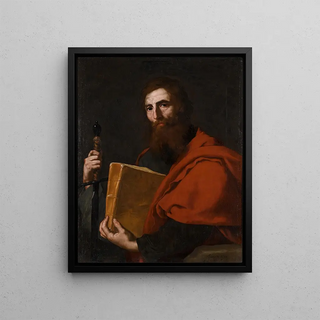Art print | Saint Paul - Jusepe de Ribera


View from behind

Frame (optional)
Saint Paul - Jusepe de Ribera – Engaging Introduction
The painting "Saint Paul" by Jusepe de Ribera is an iconic artwork that captivates with its expressive power and profound realism. This piece depicts the moment of Saint Paul's conversion, a pivotal event in Christianity that evokes spiritual transformation and the journey toward faith. The artist, renowned for his skill in capturing human emotions, succeeds in conveying an atmosphere of mystery and devotion. Through this art print, viewers are invited to immerse themselves in the baroque universe, where light and shadow play a crucial role in visual storytelling. The vibrant scene draws the eye and sparks the imagination, making this work a true masterpiece in art history.
Style and uniqueness of the work
Ribera's style is distinguished by his masterful use of chiaroscuro, a technique that enhances the contrasts between light and darkness. In "Saint Paul," this approach creates a dramatic tension that emphasizes the psychological depth of the depicted character. Saint Paul's face is imbued with palpable emotional intensity, revealing nuances of doubt and revelation. The texture of the clothing and the rendering of the hands demonstrate a meticulous attention to detail characteristic of Ribera's work. Furthermore, the composition of the canvas is carefully orchestrated, guiding the viewer's gaze toward the center of the action while maintaining a harmonious balance. Every element, from the dark background to the flashes of light, contributes to the visual impact of the scene, making this work a perfect example of Spanish baroque art.
The artist and his influence
Jusepe de Ribera, born in Spain in the early 17th century, is considered one of the masters of the baroque. His career led him to Naples, where he was influenced by the great Italian masters while developing a unique style that combines realism and spirituality. Ribera was particularly fascinated by religious themes, and "Saint Paul" is a striking illustration of this. His approach to painting inspired many artists of his time and left a lasting mark on the development of European art. By exploring profound subjects and highlighting the human condition, Ribera has

Matte finish

View from behind

Frame (optional)
Saint Paul - Jusepe de Ribera – Engaging Introduction
The painting "Saint Paul" by Jusepe de Ribera is an iconic artwork that captivates with its expressive power and profound realism. This piece depicts the moment of Saint Paul's conversion, a pivotal event in Christianity that evokes spiritual transformation and the journey toward faith. The artist, renowned for his skill in capturing human emotions, succeeds in conveying an atmosphere of mystery and devotion. Through this art print, viewers are invited to immerse themselves in the baroque universe, where light and shadow play a crucial role in visual storytelling. The vibrant scene draws the eye and sparks the imagination, making this work a true masterpiece in art history.
Style and uniqueness of the work
Ribera's style is distinguished by his masterful use of chiaroscuro, a technique that enhances the contrasts between light and darkness. In "Saint Paul," this approach creates a dramatic tension that emphasizes the psychological depth of the depicted character. Saint Paul's face is imbued with palpable emotional intensity, revealing nuances of doubt and revelation. The texture of the clothing and the rendering of the hands demonstrate a meticulous attention to detail characteristic of Ribera's work. Furthermore, the composition of the canvas is carefully orchestrated, guiding the viewer's gaze toward the center of the action while maintaining a harmonious balance. Every element, from the dark background to the flashes of light, contributes to the visual impact of the scene, making this work a perfect example of Spanish baroque art.
The artist and his influence
Jusepe de Ribera, born in Spain in the early 17th century, is considered one of the masters of the baroque. His career led him to Naples, where he was influenced by the great Italian masters while developing a unique style that combines realism and spirituality. Ribera was particularly fascinated by religious themes, and "Saint Paul" is a striking illustration of this. His approach to painting inspired many artists of his time and left a lasting mark on the development of European art. By exploring profound subjects and highlighting the human condition, Ribera has






